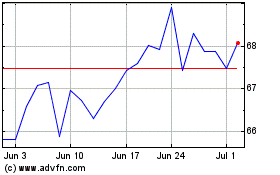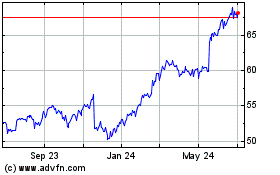Walmart Reports Strong Quarterly Results Amid Economic Challenges, Announces Vizio Acquisition and Dividend Hike
February 20 2024 - 10:37AM
IH Market News
Walmart (NYSE:WMT) delivered another quarter of impressive
results, concluding the year on a strong note as its competitive
pricing continues to draw consumers seeking value in a challenging
economic climate marked by recent inflationary pressures.
However, with inflation quickly subsiding, Walmart has observed
a decrease in customer spending per visit and, on Tuesday, issued a
conservative earnings outlook.
In a strategic move to enhance its advertising business, Walmart
has confirmed its acquisition of smart TV manufacturer Vizio for
$2.3 billion. This acquisition grants Walmart access to Vizio’s
SmartCast operating system, enabling the retail giant to offer its
vendors opportunities to showcase advertisements on streaming
platforms. Walmart highlighted that Vizio’s SmartCast system boasts
18 million active accounts.
Additionally, Walmart announced its most significant dividend
increase in over a decade, prompting a surge in its shares by more
than 5% prior to Tuesday’s market opening.
Despite economic uncertainties, the American consumer has shown
resilience, supported by a robust job market and stable income
levels. However, a noticeable pullback in spending was observed in
January following the holiday spending spree.
As one of the initial major U.S. retailers to disclose quarterly
figures, Walmart’s report could shed further light on consumer
sentiment, especially in the wake of the government’s announcement
of a marked decline in consumer spending last month.
Economists have attributed this spending reduction partly to
adverse weather conditions, but also suggest that Americans might
be feeling the strain of heightened interest rates and other
financial challenges, with potential implications extending beyond
Walmart. Consumer spending constitutes approximately two-thirds of
U.S. economic activity.
Walmart has leveraged its influence to collaborate with
suppliers in managing inflationary pressures. CEO Doug McMillon
informed industry analysts on Tuesday that prices for general
merchandise are currently lower than they were a year or even two
years ago in certain categories. The grocery sector presents a
mixed picture, with items such as eggs, apples, and deli snacks
being more affordable than the previous year, while prices for
asparagus and blackberries have seen an increase.
McMillon noted that prices for dry groceries and consumables,
including paper products and cleaning supplies, have risen by
mid-single-digit percentages compared to last year and by high
teens compared to two years ago.
Walmart continues to serve customers in need of essentials, but
it is also attracting households with annual incomes exceeding
$100,000. Notably, two-thirds of Walmart’s market share gains in
general merchandise have come from this higher-income group.
For the quarter ending January 31, Walmart reported earnings of
$5.49 billion, or $2.03 per share, down from $6.27 billion, or
$2.32 per share, in the same quarter of the previous year. Adjusted
earnings were $1.80 per share.
Revenue increased by 5.7% to $173.38 billion, surpassing
analysts’ expectations of $1.64 per share on sales of $170.85
billion, according to FactSet.
Comparable store sales, a critical measure of retail
performance, grew by 4%, a slowdown from the 4.9% growth seen in
the Walmart U.S. division in the preceding quarter and the 6.4%
growth in the second quarter. Global e-commerce sales climbed by
23%, a significant increase from the 15% growth in the prior
quarter.
However, the average spending per shopping trip dipped by 0.3%
from the previous year, despite a 4.3% increase in the number of
transactions. The decline in inflation is positive, but it
necessitates Walmart and other retailers to intensify their efforts
to sell more products.
The company’s global advertising revenue experienced a roughly
28% increase, reaching $3.4 billion.
Walmart recently unveiled plans to construct or transform over
150 stores in the next five years, alongside remodeling existing
locations. This marks a significant shift from 2016 when Walmart
announced a slowdown in new store openings to focus more on online
sales and technological advancements to compete with Amazon.
Notably, Walmart has not inaugurated a new store since late
2021.
Walmart remains committed to its stores, evidenced by enhanced
benefits for its U.S. store managers announced last month.
Starting with the current fiscal year, Walmart has introduced
stock grants of up to $20,000 annually for U.S. store managers.
For the first quarter, Walmart anticipates earnings per share to
range between $1.48 and $1.56, below the analysts’ forecast of
$1.60 per share. The company expects a 4% to 5% increase in net
sales.
For the entire fiscal year, Walmart projects earnings to be
between $6.70 and $7.12 per share, with analysts having anticipated
$7.06 per share, according to FactSet. The company foresees a 3% to
4% rise in sales for the year, a deceleration from the previous
year.
Walmart’s shares experienced a nearly 6% increase, climbing by
$9.51 per share to $179.87 on Tuesday.
Walmart (NYSE:WMT)
Historical Stock Chart
From Mar 2024 to Apr 2024

Walmart (NYSE:WMT)
Historical Stock Chart
From Apr 2023 to Apr 2024
